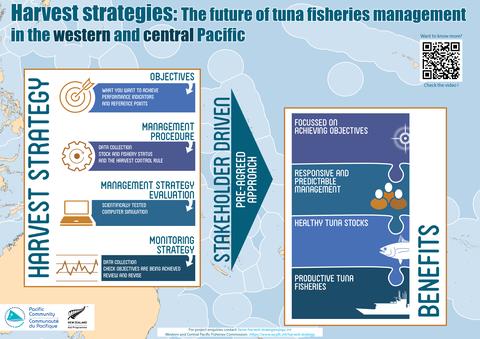Building the tools and science to inform the stakeholder-driven development of sustainable and effective management plans
The Pacific Ocean is home to some of the world’s most abundant tuna populations, with the world’s largest tuna fishing ground found in the Western and Central Pacific Ocean (WCPO). Many countries in this region fish commercially for four main tuna species – skipjack, yellowfin, bigeye, and South Pacific albacore - in what has become a multi-billion dollar industry. However, while fish stocks are renewable resources, this is only if they are managed responsibly. Poor management could lead to over exploitation of tuna in the WCPO which would have dire consequences for many Pacific Island countries.
Successful fisheries management requires timely and appropriate management action; for example, when setting catch or fishing effort limits, in order to achieve desired outcomes for the fishery. However, achieving agreement on what action to take can become increasingly challenging when a diverse set of stakeholders have different, sometimes competing objectives, such as fish stock sustainability, economic benefits, food security, and employment.
Without a clear framework for making management decisions, negotiations can become contentious, time consuming, and expensive. Management action can be delayed and often focuses on achieving short-term goals, at the expense of the longer-term objectives. Faced with the challenges of population growth, advancements in fishing technologies, and the need to enable small island developing states (SIDS) of the Pacific to retain the benefits from the fisheries that operate in their waters, a longer-term strategy is required. In response, the Western and Central Pacific Fisheries Commission (WCPFC), as the regional fisheries management organisation (RFMO) for the WCPO, agreed to a work-plan for the adoption of “harvest strategies” for the four target tuna species.

What is a harvest strategy?
A harvest strategy is a formalised process for making decisions on management actions, so that there is the best chance of achieving agreed management objectives for the fishery and over the long-term. A central idea is that of ‘pre-agreeing’ management actions; that is, agreeing in advance what action to take given the status of the stock. Pre-agreement of management decisions leads to more timely management action resulting in greater stability for industry, and more consistent progress towards long-term objectives. This makes the whole process of managing the fishery more responsive and predictable, provides greater certainty, and gives all stakeholders a clear, long-term vision of a sustainable stock and fishery.
Importantly, the development of a harvest strategy is a stakeholder led process. Stakeholders specify the objectives for the fishery and are actively involved in all important decisions relating to the design, testing and implementation of the harvest strategy.
As part of our role as the Scientific Service Provider for the WCPFC, we are supporting the development of harvest strategies for the four main tuna stocks in the region: skipjack, bigeye, yellowfin and South Pacific albacore. This work includes building the technical tools and robust science alongside a comprehensive stakeholder engagement programme to ensure that all members of the WCPFC can actively contribute to progressing the strategies that will impact their fisheries.
Much of this work is conducted as part of the "Pacific Tuna Management Strategy Evaluation Project" funded by the New Zealand Ministry of Foreign Affairs and Trade.
For project enquiries, please contact [email protected]
